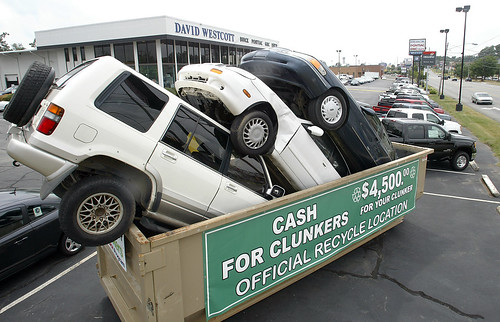(Sources: Autoblog Green , Green Car Congress, NY Times Wheels, Green Car Reports)
The internet as well as the automotive world has been abuzz with a lot of discussions since this morning after General Motors CEO Fritz Henderson revealed what the company’s mysterious ‘230’ ad campaign was about. It turned out to be the official mileage rating for GM’s upcoming 2011 Chevrolet Volt extended-range electric car.
GM must be basking in the new found glory (though it sounds more temporary as the intelligent folks around the web are starting to dig out the details behind this 230mpg claim). GM’s Twitter account was proudly re-tweeting a post that goes like this: 230 mpg city, great. More than 100 mpg combined, even better. Not being stranded after 300+ miles, priceless. Mind you! This is just a sample of what’s been such a flood of good PR for GM. after this 230 unveiling.

For many smart folks, a number like that seems outlandish, absurd. How can the US Environmental Protection Agency possibly measure fuel consumption that low? The answer, it turns out, is all in the assumptions.
Our friends at Autoblog says “Without access to the actual method that the EPA is tentatively going to apply to plug-in vehicles (we have requests for clarification out to the EPA), all that GM’s Dave Darovitz would tell us is that the number is “based on city cycles and we’re not really talking in detail yet.” Instead, the press release says that: Under the new methodology being developed, EPA weights plug-in electric vehicles as traveling more city miles than highway miles on only electricity. The EPA methodology uses kilowatt hours per 100 miles traveled to define the electrical efficiency of plug-ins. Applying EPA’s methodology, GM expects the Volt to consume as little as 25 kilowatt hours per 100 miles in city driving. At the U.S. average cost of electricity (approximately 11 cents per kWh), a typical Volt driver would pay about $2.75 for electricity to travel 100 miles, or less than 3 cents per mile.
Which leads to the big question: What assumptions should the EPA make in its emissions and gas-mileage tests about how the Volt is used (also known as the car’s “duty cycle”)?
For decades, gasoline cars (and ) have been testing using two cycles: city and highway. That gives us the two quoted EPA mileage ratings, and the EPA also calculates a “blended” number for overall usage. The distance driven doesn’t really matter.
But for the Volt, mileage assumptions become much more political. If the EPA tests a Volt over a cycle of less than 40 miles, it will never burn any gasoline, and it’ll get that “infinite” mileage. The daily distance matters much more for the Volt than for a gas engined car.
The answer appears to be the EPA has adopted a cycle described by GM-Volt.com, among others, that assumes the Volt is driven until the battery is discharged–and then slightly more on gasoline power.
A similar test routine proposed by Mike Duoba at Argonne National Laboratories repeatedly drives the car on four EPA highway test cycles until the battery is discharged, then drives one city cycle–totaling 51 miles. (The EPA city cycle is roughly 11 miles, the highway cycle about 10 miles.)

If the engine runs for 11 miles at 50 mpg, that will use 0.22 gallons of gasoline. But that amount is used over a total travel distance of 51 miles, which works out to 232 mpg. Sounds like 230 mpg to us!
Jim Motavalli wrote on his Wheels column on New York Times : The problem with claiming 230 miles a gallon was that to get at numbers like that you can’t simply measure its fuel consumption. The plug-in hybrid’s small gas engine is there to provide power for the electric motors, not drive the wheels, and the first 40 miles are on the batteries alone.
G.M. can plug its numbers into the E.P.A. city driving cycle and get stellar results, but, as they say, actual results — and planetary impact — will vary quite a bit. How and where you drive the Volt will matter quite a bit, too. “If you’re heavy footed, you’re not going to get 230 miles per gallon,” said Roland Hwang, transportation program director at the Natural Resources Defense Council.
In a detailed article published by Green Car Congress one can learn how this fuel economy rating is measured. While the fuel economy (FE) for combustible fueled vehicles (such as gasoline, diesel, compressed natural gas, or an ethanol blend) can easily be expressed in mpg, and fuel economy for an all-electric vehicle can be expressed in miles per gallon of gasoline equivalent (mpge), the arrival of new technologies that can operate in all-electric mode, a conventional hybrid mode, or some combination of the two complicates the situation.
The EPA is revisiting the FE label provisions as they apply to those types of vehicles, and is working with automakers, the SAE, the State of California, the Department of Energy and others to address these issues. The EPA anticipates issuing guidance and/or a rule this year.
According to US Department of Transportation data, nearly eight of 10 Americans commute fewer than 40 miles a day. A Volt driver’s actual gas-free mileage will vary depending on how far he or she travels and other factors, such as how much cargo or how many passengers they carry and how much the air conditioner or other accessories are used. Tony Posawatz, Vehicle Line Director for the Volt, said that the Volt is delivering 40 miles all electric in both city and highway cycles.
However, Posawatz notes that since the Volt results are based on a single charge per day—and that given the recharge time of 6-8 hours on a standard 110V outlet or half that on a 240V charger, the Volt has the potential to deliver better than 230 mpg performance if it can charge multiple times per day.
Click here to read the entire article.










 Registration Information
Registration Information